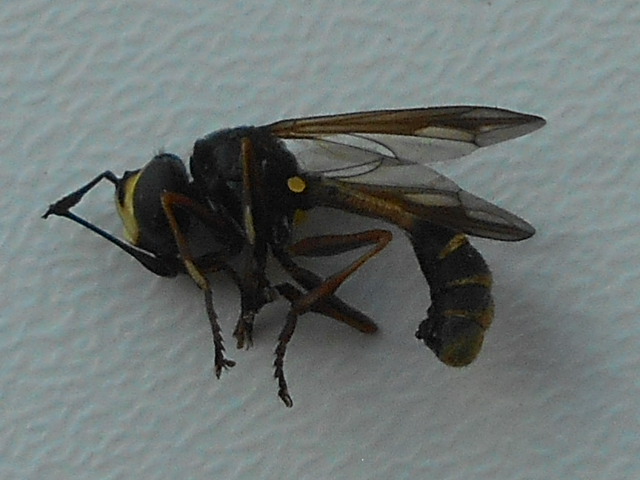I set out in high spirits but was distracted before even leaving our front garden. Nectaring on a scabious plant was the large and handsome hoverfly, Volucella inanis.
 |
The hoverfly, Volucella inanis, in our front garden.
31 July, 2017
|
This is yet another species, once restricted to England's southern counties, that is moving ever more northwards. One assumes this is a response to climate warming though it is not really safe to jump to conclusions.
I paused yet again to photograph the 'monster' at the end of Christchurch Drive. This whimsical creation has been constructed by the careful clipping of a hedge of Wilson's Honeysuckle, Lonicera nitida.
 |
A monster of Wilson's Honeysuckle. Christchurch Drive, Daventry.
31 July, 2017
|
This shrub, native to Yunnan and adjacent regions of China, was brought over to this country by the famous plant hunter, Ernest 'Chinese' Wilson. Oddly enough, only five days ago I was in Chipping Campden, where a garden has been created in his memory. I don't think he visualised the plant being used in this way.
Anyway, I set off again. The Grange is not an area of beauty but has many distractions such as this clump of poppies, Papaver rhoeas. Yesterday commemoratives services were held to honour those who died or were injured at Passchendaele in World War One.
 |
Papaver rhoeas, the poppy of 'Flanders Fields'. The Grange, Daventry.
31 July, 2017
|
Poppies are rapid colonisers of disturbed ground and were quick to move in and exploit the newly created yet ghastly battlefield habitat. In Britain it is not a native plant but is classed as an archaeophyte, perhaps having been accidentally introduced to this country by neolithic farmers - but we may never know. The species is poisonous in all its parts due to the presence of rhoeadine and morphine. These are, of course, valuable alkaloids medicinally, having sedative and antitussive effects.
Another plant brightening up odd spaces was Nipplewort, Lapsana communis. Its cheerful yellow flowers are often ignored yet are worthy of a second glance. As the unopened flower buds resembled nipples the plant was used, in accordance with the 'doctrine of signatures' for the treatment of breast ulcers.
 |
Nipplewort brightens an otherwise dull wall. The Grange, Daventry.
31 July, 2017
|
Most of its relatives have fruits bearing a feathery pappus - the dandelion is the obvious example - but although the nipplewort lacks pappi it is very successful in exploiting new opportunities and is abundant everywhere. The rather bitter leaves were once used in salads but rarely get a mention from Messrs Oliver, Lawson or Berry.
 |
Nipplewort merits a closer look.
|
At this point I stopped to photograph a graceful tree near to The Stour (the local streets are named after English rivers). It was the common native Silver Birch. A.E.Housman wrote:
The loveliest of trees, the cherry now
Is hung with blossom along the bough.
Well, I wouldn't argue with that, but the cherry has long lost its blossom, surely leaving the Silver Birch supreme.
I still had a mile to go to Kentle Wood but in fact got no further. I took a rather casual sweep with my net through the birch foliage - and was staggered by the number of insect species taken.
 |
What a graceful tree is the Silver Birch. The Grange, Daventry.
31 July, 2017
|
Bugs were particularly well represented (there were literally dozens of Parent Bugs) so I decided that Kentle Wood would have to wait for another day.
 |
| The Parent Bug, Elasmucha grisea, was abundant on a birch tree. |
The area has many trees, with oak, beech, ash, rowan, common lime, hornbeam, horse chestnut, aspen and sycamore present. There is too Red Oak, Quercus rubra, from the east of North America.
 |
Red Oak has particularly attractive foliage. The Grange, Daventry.
31 July, 2017
|
I searched in vain for acorns and contented myself with leaves. Bearing in mind this variety of trees I should surely pay The Grange a little more attention.














































